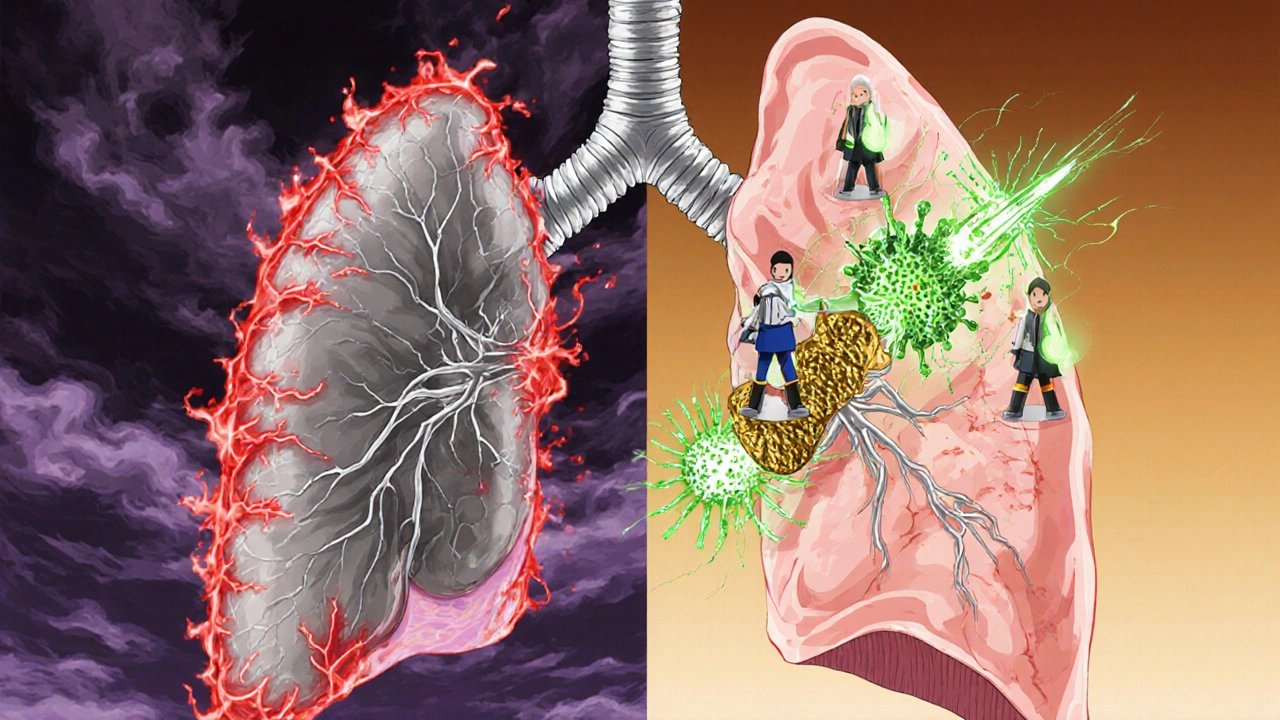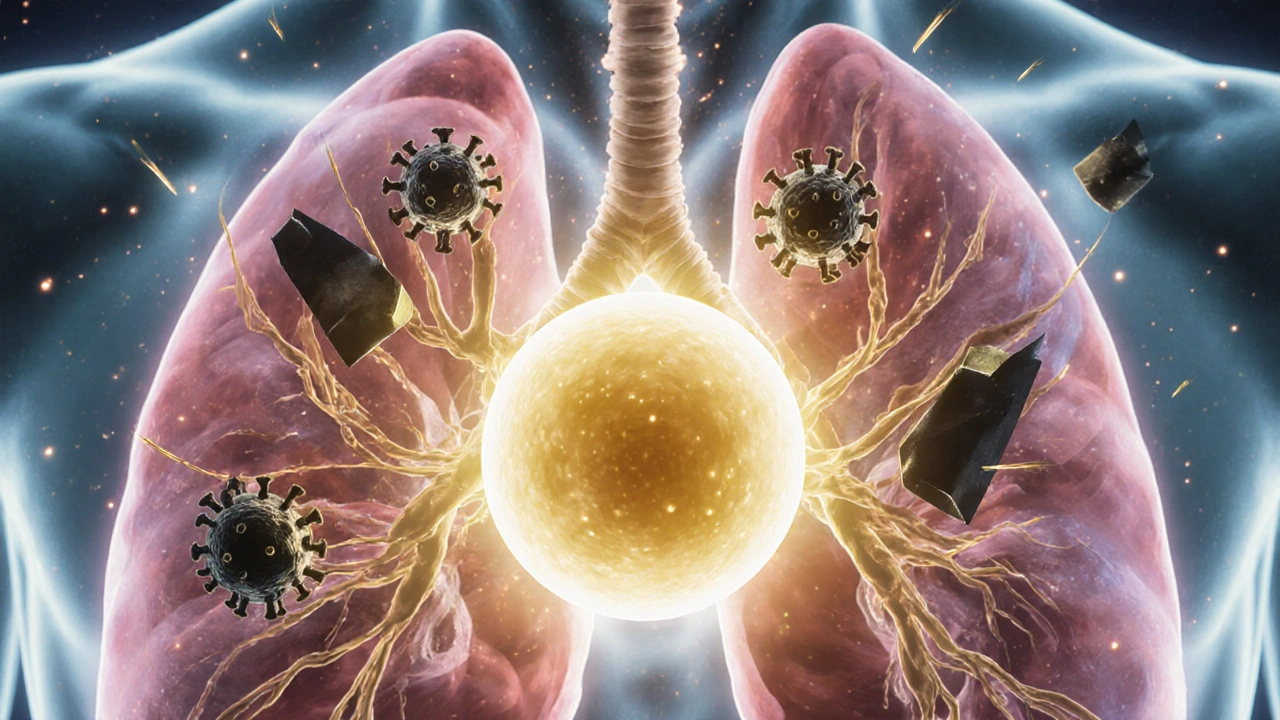When your lungs feel tight after a cold, or you keep getting respiratory infections year after year, the problem might not be just viruses or pollution. One overlooked player in your respiratory health is calcitriol-the active form of vitamin D. It’s not just about bone strength. Calcitriol quietly runs the show in your lungs, helping your immune system fight off infections and keeping inflammation in check. If your levels are low, your lungs pay the price.
What exactly is calcitriol?
Calcitriol, or 1,25-dihydroxyvitamin D, is the hormone your body makes from vitamin D. You get vitamin D from sunlight, fatty fish, eggs, or supplements. But your liver and kidneys have to convert it into calcitriol before your body can use it. Once it’s active, calcitriol doesn’t just help your gut absorb calcium. It talks directly to immune cells in your lungs, airways, and even the lining of your nose.
Think of calcitriol as a traffic controller for your immune system. It tells certain immune cells to stand down when there’s no threat-reducing chronic inflammation. At the same time, it boosts the production of antimicrobial peptides like cathelicidin, which act like natural antibiotics in your airways. These peptides punch holes in viruses and bacteria before they can take hold.
Low calcitriol and higher risk of respiratory infections
People with low calcitriol levels are more likely to catch colds, flu, bronchitis, and even pneumonia. A 2023 meta-analysis of over 11,000 adults found that those with vitamin D levels below 20 ng/mL had a 36% higher risk of lower respiratory tract infections compared to those above 30 ng/mL. This wasn’t just correlation. In controlled trials, supplementing with vitamin D reduced the number of respiratory infections by about 12% over a year.
In Australia, where winter sunlight is weak and many people stay indoors, low calcitriol is common. A 2024 study in Sydney found that 42% of adults over 50 had levels below the recommended threshold. These same people reported more days off work due to coughs and congestion. It’s not just the elderly-teenagers with asthma who had low calcitriol were twice as likely to need emergency care during flu season.
Calcitriol and chronic lung conditions
It’s not just about catching infections. Calcitriol plays a role in long-term lung health too. In people with asthma, low calcitriol is linked to worse control, more nighttime symptoms, and higher steroid use. In COPD patients, low levels correlate with faster decline in lung function and more frequent flare-ups.
Why? Because calcitriol helps regulate the balance between pro-inflammatory and anti-inflammatory signals in lung tissue. When calcitriol is low, your lungs stay in a state of low-grade inflammation. Over time, this damages the airway lining and weakens the muscles that help you breathe. In emphysema, calcitriol helps slow down the breakdown of lung tissue by suppressing enzymes that chew up the alveoli-the tiny air sacs where oxygen enters your blood.
One small but telling study in Melbourne followed 80 COPD patients for 18 months. Half took 1,000 IU of vitamin D daily. The group with higher calcitriol levels had 30% fewer exacerbations and reported better breathing during daily tasks like climbing stairs.

How calcitriol helps your lungs fight viruses
When a virus like influenza or RSV enters your airways, your immune system goes on high alert. Calcitriol steps in early. It activates a protein called TLR2 on lung cells, which acts like a smoke alarm for viruses. Once triggered, the cells start producing cathelicidin and defensins-natural antiviral compounds that stop the virus from replicating.
Studies show that calcitriol can reduce viral load in the lungs by up to 60% in lab models. It also prevents the immune system from overreacting. Too much inflammation in the lungs leads to cytokine storms-a dangerous condition seen in severe COVID-19. Calcitriol helps keep the immune response balanced, reducing the chance of severe illness.
During the peak of the pandemic, hospitals in the U.S. and Europe noticed that patients with vitamin D deficiency were more likely to need oxygen or ICU care. While vitamin D wasn’t a cure, it was a protective layer. Those with adequate levels were less likely to crash.
How to get enough calcitriol
You can’t get calcitriol directly from food or supplements. Your body has to make it. So the goal is to support your body’s ability to produce it.
- Sunlight: 10-20 minutes of midday sun on your arms and legs, without sunscreen, 3-4 times a week, is enough for most people. In Sydney, that’s doable in spring and summer. In winter, you might need more time or a supplement.
- Diet: Fatty fish like salmon, mackerel, and sardines are your best food sources. One 100g serving of cooked salmon gives you about 570 IU of vitamin D. Eggs and fortified milk help too, but not enough on their own.
- Supplements: For most adults, 1,000-2,000 IU of vitamin D3 daily is safe and effective. If you’re over 60, have dark skin, or live in a low-sun area, 2,000-4,000 IU may be needed. Always get your blood level tested before going over 4,000 IU daily.
Don’t confuse vitamin D2 with D3. D3 (cholecalciferol) is the form your body uses best. Most supplements are D3. Avoid D2 unless prescribed.
Who’s at risk of low calcitriol?
- People with darker skin (melanin blocks UVB rays)
- Older adults (skin makes less vitamin D as you age)
- Those who stay indoors most of the day
- People with obesity (vitamin D gets trapped in fat tissue)
- Anyone with kidney or liver disease (can’t convert vitamin D to calcitriol)
- People taking steroids or certain seizure meds
If you have asthma, COPD, frequent sinus infections, or get sick every winter, get your 25-hydroxyvitamin D level checked. It’s a simple blood test. Optimal levels for respiratory health are between 40-60 ng/mL-not just the ‘normal’ range of 30-100 ng/mL that labs list.

What happens if you take too much?
Calcitriol itself is tightly controlled by your body. You can’t overdose on it from sunlight or food. But taking very high-dose supplements-like 10,000 IU daily for months-can raise calcium levels too high. That can lead to kidney stones, nausea, or heart rhythm issues. That’s why sticking to 4,000 IU daily unless under medical supervision is the safest bet.
Also, don’t take calcitriol pills (like Rocaltrol) unless prescribed. Those are synthetic hormones used for kidney disease or parathyroid disorders. They’re not meant for general use and can be dangerous if misused.
Real-life impact: A Sydney case
One 68-year-old man in Bondi came in with recurring pneumonia. He’d been hospitalized three times in two years. He didn’t smoke. He ate well. But he rarely went outside. His vitamin D level was 12 ng/mL. After starting 2,000 IU of D3 daily and walking 30 minutes in the morning sun, his infections dropped to zero over the next 14 months. His lung function tests improved. He didn’t need antibiotics anymore.
This isn’t magic. It’s biology. His body finally had the calcitriol it needed to keep his airways protected.
Bottom line: Calcitriol isn’t optional for lung health
Your lungs don’t just need oxygen-they need calcitriol. It’s not a supplement you take to feel better. It’s a hormone your body uses to stay healthy. If you’re constantly catching colds, struggling with asthma, or feeling breathless after walking up stairs, low calcitriol might be part of the puzzle.
Get your levels tested. Get some sun. Eat fatty fish. Take a simple D3 supplement if needed. It’s one of the cheapest, safest, and most effective things you can do for your respiratory health right now.
Can low calcitriol cause shortness of breath?
Yes. Low calcitriol doesn’t directly cause shortness of breath, but it weakens your lungs’ defenses and increases inflammation. This can make existing conditions like asthma or COPD worse, leading to more frequent breathlessness. In some cases, people report feeling less winded after correcting low vitamin D levels-even without other treatment changes.
Is calcitriol the same as vitamin D?
No. Vitamin D (cholecalciferol or ergocalciferol) is the inactive form you get from sun, food, or supplements. Calcitriol is the active hormone your liver and kidneys make from it. Your body only produces calcitriol when it needs it, so you can’t buy it over the counter. Supplements give you vitamin D, not calcitriol.
How long does it take for calcitriol to improve lung health?
It varies. Some people notice fewer colds within 4-6 weeks of starting vitamin D supplements. For chronic conditions like asthma or COPD, it can take 3-6 months to see measurable improvements in lung function or flare-up frequency. Consistency matters more than speed.
Should I take calcitriol supplements?
No. Calcitriol supplements (like Rocaltrol) are prescription-only drugs used for specific medical conditions like kidney failure or hypoparathyroidism. Taking them without a doctor’s supervision can cause dangerous calcium spikes. Always take vitamin D3 instead, and only use calcitriol if your doctor prescribes it.
Can children benefit from calcitriol for respiratory health?
Yes. Children with low vitamin D levels have higher rates of wheezing, asthma attacks, and pneumonia. The American Academy of Pediatrics recommends 400 IU of vitamin D daily for infants and 600 IU for children over 1. In high-risk groups-like those with dark skin or little sun exposure-up to 1,000 IU daily is often safe and helpful.


